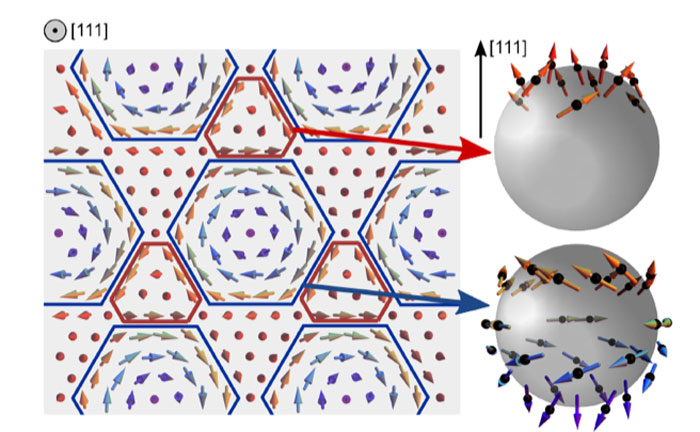Frustrated antiferromagnets in a whorl
Tiny vortices in magnetic materials called skyrmions act like quantum particles. If able to be stabilised and then manipulated, they could lead the next-generation of electronic devices that exploit magnetic spin to transfer and store information. A new type of skyrmion discovered in an antiferromagnetic compound could wind up progress in the right direction.
The study of complex magnetic behaviour right at the nano-level has become an intense area of study with exciting applications. In some materials containing magnetic atoms (that is, with unpaired electrons that thus endow a magnetic moment or spin with a direction that can be up or down), the spins of atoms close to each other may couple and align in a complicated way due to competing magnetic interactions between several near neighbours – a phenomenon called ‘frustration’. This can create a dynamic magnetic structure, characterised by fluctuating spin directions, called a spin liquid. Spiral arrangements of spins may be observed – or various types of two-dimensional complex magnetic arrangements called spin textures may form. If the fluctuations in such spin alignments can be manipulated, this provides another way of transferring or storing electronic information.
An important tool to understand these phenomena is the area of mathematics called topology, which geometrically classifies objects or spaces as being equivalent if they can be transformed from one to the other by continuous deformation without breaking their surfaces – for example, by stretching or twisting. A one-dimensional example of a topological class are knots. These of course can be very stable, and it is this topological stability that is of great interest when applied to continually twisting alignments of spins in such materials.
One type of stable topological magnetic object discovered about a decade ago, are tiny vortices of magnetic spins wound up so that they gradually change from ‘up’ at the edge of the whirlpool to ‘down’ in its centre. Topologically, they can be thought of as wrapping around a sphere. Called skyrmions after the UK theorist Tony Skyrme, physicists believe that these nanometre-sized ‘quasiparticles’ could be used to carry information in the next generation of electronic devices that exploit magnetic spin (spintronics), including storage devices and sensors. They could also be developed as spin logic gates for computing. There are a various kinds of skyrmions and related topological magnetic quasiparticles, which have the potential to be moved and manipulated just like conducting electrons. The new field of ‘skyrmionics’ shows great technological promise.
A new type of skyrmion
So far, the skyrmions identified are found in ferromagnetic materials, that is, containing magnetic atoms with all the spins aligned. They form due to the interplay of frustrated interactions between several nearest-neighbour magnetic atoms. However, we became interested in discovering whether skyrmions could also exist in antiferromagnetic materials (spins aligned anti-parallel) also characterised by frustrated alignments. We focused on a spinel-type mineral, manganese scandium sulfide (MnSc2S4). The magnetic manganese atoms form a slightly distorted diamond-type arrangement in which the spins on nearest-neighbour atoms couple ferromagnetically and on next-nearest antiferromagnetically. The differing distances between near-neighours leads to high magnetic frustration and enhanced spin fluctuations. In previous neutron-diffraction work on this material, we had indeed observed an emerging spiral spin-liquid state.
In our new experiments, we carried out inelastic neutron scattering on a powder and single-single samples. This allowed us to measure the magnetic interactions between the manganese atoms, as revealed in a spectrum of the corresponding changes in neutron energy after the neutron beam had passed through the sample. (Neutrons also have a magnetic moment so are an excellent probe of complex magnetic materials.) A magnetic field was applied to stabilise the magnetic structure in the sample.
We then compared the neutron spectra with computer simulations of what we might see. The results could be interpreted as follows. The manganese atoms, in fact, form a series of triangular lattices that could be separated further into three sublattices. When stacked together, they form spin ‘whorls’. The wrapping of spins around the previously mentioned topological sphere is not complete, giving fractional skyrmions with opposite winding directions. It does seem, therefore, that skyrmion-type structures could be stabilised in antiferromagnetic compounds. This would be an important step to realising efficient, nano-size spintronic devices.
Nature (London), 2020, 586, 37; doi: 10.1038/s41586-020-2716-8
ILL Instruments: the three-axis spectrometer Thales and the single-crystal diffractometer D23
Other instruments: single-crystal diffractometer Zebra (PSI) and three-axis spectrometer PANDA (MLZ)
Contact:Oksana Zaharko (Paul Scherrer Institute)
ILL contact: Paul Steffens


